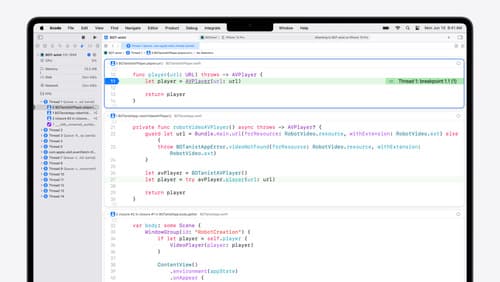how to ensure a class is thread safe
Asked on 2024-08-13
1 search
To ensure a class is thread-safe in Swift, you can utilize several features introduced in Swift 6 that focus on data race safety and concurrency. Here are some key points:
-
Actors: Swift introduces actors, which are reference types similar to classes but automatically protect their state by serializing accesses. This means only a single task can execute at a time on an actor, making it a convenient way to ensure thread safety. You can convert a class to an actor to make concurrent accesses safe. For more details, you can refer to the session A Swift Tour: Explore Swift’s features and design.
-
Sendable Protocol: In Swift 6, data race safety is achieved by ensuring that values shared between concurrency domains are sendable. A sendable value protects its state from concurrent accesses, often by acquiring a lock while reading and writing mutable state. If a class is not sendable, you might need to add synchronization manually or use actors.
-
Swift 6 Language Mode: This mode introduces full enforcement of data isolation, preventing accidental sharing of state between tasks and actors. It turns data race issues into compile-time errors, significantly improving the safety of your code. You can adopt this mode to catch concurrency issues early. For more information, see the session Migrate your app to Swift 6.
-
Concurrency Checking: You can enable strict concurrency checking in your project's build settings to identify potential race conditions. This is done on a per-target basis and can be particularly useful for ensuring that your UI layer, which often runs on the main thread, is concurrency-safe. More details can be found in the session Migrate your app to Swift 6.
By leveraging these features, you can ensure that your classes are thread-safe and free from data races in Swift.

What’s new in Xcode 16
Discover the latest productivity and performance improvements in Xcode 16. Learn about enhancements to code completion, diagnostics, and Xcode Previews. Find out more about updates in builds and explore improvements in debugging and Instruments.

Migrate your app to Swift 6
Experience Swift 6 migration in action as we update an existing sample app. Learn how to migrate incrementally, module by module, and how the compiler helps you identify code that’s at risk of data races. Discover different techniques for ensuring clear isolation boundaries and eliminating concurrent access to shared mutable state.

A Swift Tour: Explore Swift’s features and design
Learn the essential features and design philosophy of the Swift programming language. We’ll explore how to model data, handle errors, use protocols, write concurrent code, and more while building up a Swift package that has a library, an HTTP server, and a command line client. Whether you’re just beginning your Swift journey or have been with us from the start, this talk will help you get the most out of the language.
